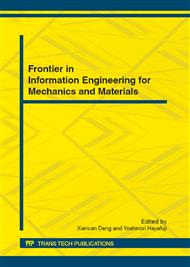[1]
Cristina Buzea, Ivan Pacheco, and Kevin Robbie. Nanomaterials and Nanoparticles: Sources and Toxicity. Biointerphases, 2007(2): MR17.
DOI: 10.1116/1.2815690
Google Scholar
[2]
SENG D., LIANG X. 3D Visualization Techniques of Complex Virtual Scene in Hydraulic Engineering. 2009 1st International Conference on Information Science and Engineering, 2009. 12.
DOI: 10.1109/icise.2009.6
Google Scholar
[3]
Scholz W., Suss W. , Schrefl T. Micromagnetic simulation of structure property relations in hard and soft magnets. Comput. Mat. Sci., (2000).
DOI: 10.1016/s0927-0256(99)00094-4
Google Scholar
[4]
SENG D., SONG Z. Method and system for virtual roaming in water conservancy works. 2009 International Conference on Intelligent Human-Machine Systems and Cybernetics, 2009. 08.
DOI: 10.1109/ihmsc.2009.85
Google Scholar
[5]
S.K. Prasad. Modern Concepts in Nanotechnology. Discovery Publishing House, 2008, pp.31-32.
Google Scholar
[6]
SENG Dewen, LI Zhongxue. Design and implementation of a 3D simulation system for geological and mining engineering. Journal of Liaoning Technical University, Vol. 27(1), pp.9-12, 2008. 02.
Google Scholar
[7]
Fritz Allhoff, Patrick Lin, Daniel Moore. What is nanotechnology and why does it matter?: from science to ethics. John Wiley and Sons, 2010, pp.3-5.
DOI: 10.1007/s11024-013-9241-y
Google Scholar
[8]
SENG D., WANG H. Realistic Real-time Rendering of 3D Terrain Scenes Based on OpenGL. International Conference on Information Science and Engineering, 2009. 12.
DOI: 10.1109/icise.2009.871
Google Scholar
[9]
Schiotz J., Tolla F. D., Jacobsen W. . Softening of nanocrystalline metals at very small grain size. Nature, 1998, 391: 561.
DOI: 10.1038/35328
Google Scholar
[10]
SENG D., SONG Z., WANG H. Construction and Visualization of Complicated Objects for 3D GIS. Geoinformatics 2008 and Joint Conference on GIS and Built Environment: Geo-Simulation and Virtual GIS Environments, Proc. of SPIE Vol. 7143, 2008. 06.
DOI: 10.1117/12.812642
Google Scholar
[11]
Lannacone G. ,Coli P. Three dimensional simulation of nanocrystal flash memories. Appl. Phys. Lett., 2001, 78(14): 204.
DOI: 10.1063/1.1361097
Google Scholar
[12]
SENG D., Chen W. Application of RS Theory and SVM in the Ore-rock Classification. 2009 International Conference on Computational Intelligence and Software Engineering, 2009. 12.
DOI: 10.1109/cise.2009.5365160
Google Scholar
[13]
Steven W., Levine, Paulette Claney. A simple model for the growth of polycrystalline Si using the kinetic Monte Carlo simulation. Modelling Simul. Mater. Sci. Eng., 2000, 8: 751.
DOI: 10.1088/0965-0393/8/5/308
Google Scholar
[14]
SENG D. Framework and Key Technologies for the Construction of a Virtual Mine. International Conference on Multimedia Technology, 2010. 10.
DOI: 10.1109/icmult.2010.5629720
Google Scholar
[15]
Veena Tikare. Three dimensional simulation of grain growth in the presence of mobile pores. J. Am. Ceram. Soc., 2001, 84(6): 1379.
Google Scholar
[16]
SENG D., Chen W. 3D Visualization and Interaction Technologies Applied in the Modeling of Geological Bodies. 2010 International Conference on Computer Application and System Modeling, 2010. 10.
DOI: 10.1109/iccasm.2010.5620158
Google Scholar
[17]
Kubik T, Bogunia-Kubik K, Sugisaka M. Nanotechnology on duty in medical applications. Curr Pharm Biotechnol, 2005, 6(1): 17-33.
DOI: 10.2174/1389201053167248
Google Scholar


